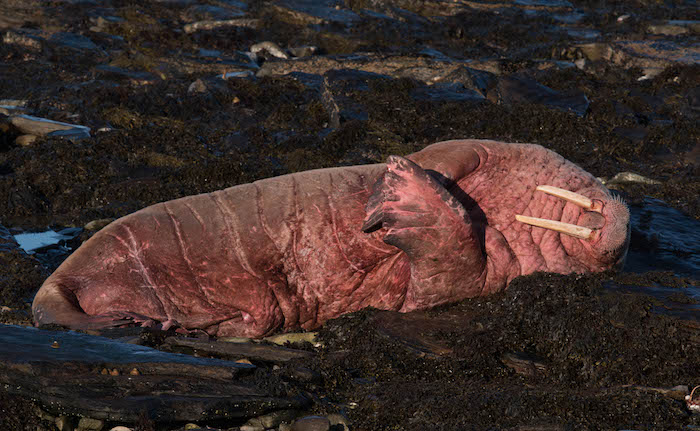

Visiting walrus makes waves in Orkney

Orkney is currently playing host to an unusual wild visitor normally found further north. A male walrus has appeared on the coast of Sanday — the first time one of the tusked animals has been seen in the county for five years.
The marine mammal was first spotted yesterday afternoon, Thursday, in waters near North Ronaldsay, by a volunteer at the island’s bird observatory.
However, the walrus was sighted in Sanday early this morning, having pulled itself ashore just below Sandquoy bay, in the north east end of the island.
The walrus is looking healthy and relaxed and has caused quite a stir on the island, with plenty of the locals heading over to have a look at their unusual visitor, according to Sanday Ranger Emma Neave-Webb.
The last time a walrus was seen in Orkney, was on March 3, 2013, when an adult male arrived in North Ronaldsay. That visit proved to be a short one, however, with the animal moving on by 4pm that same day.
Commenting in 2013, walrus and polar bear expert at the Greenland Institute of Natural Resources Erik W. Born said: “There has been much speculation as to why migrant walruses suddenly turn up in Europe — in recent times, the farthest south has been on the northern coast of Spain. There have been several observations along the Norwegian coast, some in Iceland, Faroe and north-west continental Europe.
“Walruses migrate in their northern range between near-shore feeding banks, so it is no problem for a walrus to migrate far. But why?
“Some have suggested that an apparent increased occurrence of migrants may represent an increase in the populations in eastern Greenland and Svalbard-Franz Joseph Land. Others claim that it may represent change in climate. But, on the other hand, during the ‘Little Ice Age’, around 1600, walruses occurred regularly in northern Scotland and northern Norway. So one would not expect an increase of migrants when it is getting warmer.”
Prior to that, there had only been one other recorded walrus sighting in the county, in August, 1986, on Eynhallow.
Walruses are usually found further north than Orkney, being native to the Arctic Ocean and subarctic seas of the northern hemisphere.